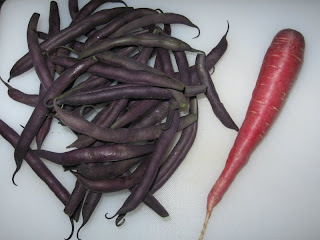The Color Purple: Royal Burgundy Beans and Cosmic Purple Carrot
My loaf started looking somewhat turbanesque


But as it rose, and spread, it became decidedly more beret-like


It baked up fine, however.

As an enriched bread the loaf was nice and tender and it tasted very good. We would definitely recommend this bread, Judy.

As you can see, I may not have diced the apples finely enough, but the chunks were nice in the finished product.
Next we moved from apples to sweet potatoes. And spelt. From previous posts (Olive Spelt Bread and Roasted Garlic Bread) we know that spelt is basically an heirloom wheat grown mostly in Europe for livestock feed. Like many of the other less common grains we have used, spelt is hardy and can be grown in difficult conditions.
As for Sweet Potatoes, they seem to suffer from a bit of an identity crisis. Sometimes they are called sweet potatoes and sometimes they are called yams. There also appears to be somewhat of a regional convention. Our daughter Ellen is a graduate of Clemson in South Carolina. She observed that when you simply asked for a "potato" there, you got a sweet potato. To get what she considered to be the "default potato" she needed to specify an Irish Potato.
Wikipedia offers that "[t]he softer, orange variety is often called a yam in parts of North America, a practice intended to differentiate it from the firmer and more nutritious variety of sweet potato that is beige on the outside and yellow on the inside." But, as Wikipedia notes, "yam" is also a tuber "which is native to Africa and Asia and belongs to the monocot family Dioscoreaceae." (This is as opposed to the sweet potato which the article notes "is a dicotyledonous plant that belongs to the family Convolvulaceae.") The African/Asian yams "can grow up to 1.5 m (4.9 ft) in length and weigh up to 70 kg (154 lb)." Good thing the recipe specified one large sweet potato rather than one large yam! According to Wikipedia, "[t]o prevent confusion, the United States Department of Agriculture requires sweet potatoes labeled as 'yams' to be labeled also as 'sweet potatoes'." Well, as usual, the government has fixed everything.
This bread was pretty straight forward--just a basic dough using spelt and AP flour. The only addition was a shredded sweet potato. My sweet potato was orange on the inside, (it should have had a sign stating "I yam what I yam") and I shredded it with the skin on to preserve nutrients.
Instead of forming an oval loaf as the recipe suggested I baked it as a boule. I formed it into a ball and placed it in my frozen whipped topping container couche lined with parchment paper. Then I covered it with a recycled hotel shower cap and let it rise.
We spare no expense in pursuit of HB in 5 excellence.
(Actually, that is not true. Judy over at Judy's Bakery of Johnson City
did a test, comparing King Arthur Flour to Sam's Club Flour. She felt that KA flour gave noticeably better
results, though that opinion was not shared by all her tasters. Also, Sam's is bleached (KA is not), and Jeff and Zoe have specified that it is important to use unbleached flour in their breads. I use Gold Medal Unbleached and get it when it goes on sale.
My suspicion, which is shared by some of Judy's testers, is that the KA difference would be much less significant in
the whole grain breads I bake, where the AP flour is just a fraction of
the flour in the recipe, than it appears to be in an all AP flour bread. So I do spare the expense of KA flour.)
I baked the Sweet Potato Bread in my Flame Orange Le Creuset covered pot, uncovering it about 2/3 of the way through.
The sweet potato in the dough kept the bread very moist. In fact, the first attempt looked done at the time specified in the recipe, so I took it out. It fell! So I baked the other loaf about half again as long, and took its temperature before I pulled it out. It was still pretty moist, but at least firm enough to stand.
The bread was just OK, quite soft and tender, and a little too moist. It is possible that I added too much sweet potato, and that is why it seemed to moist. I did not notice a particular sweet potato flavor, however. We liked it much better toasted.
So that is it for this, the penultimate assignment. Only one more to go. Tune in again next time for the big finish!









Congrats on your 41st post!!!!!! I'm so proud! :)
ReplyDelete-Becca
I love your turban and your makeshift banneton. Very creative. I had big chunks of apples in my bread as well. I liked the challah. I'll be making the sweet potato and spelt bread next. Happy Baking!
ReplyDeleteTurban or beret, it looks very tasty. I really like the flame orange pan. Yam or sweet potato, it's all confusing to me. I not fond of them either way.
ReplyDeleteGreat breads!